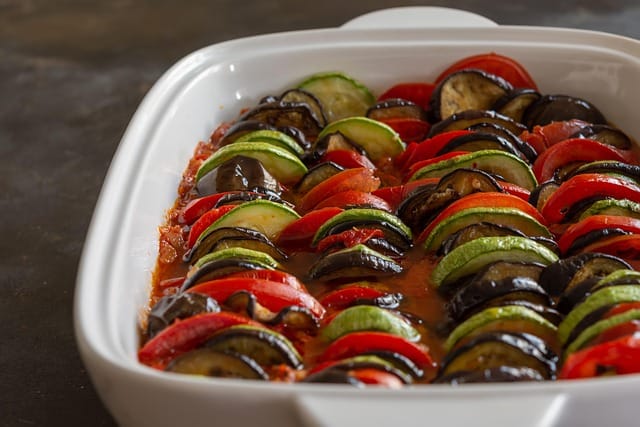Discover the Magic of Ratatouille: A Flavorful French Classic for Every Kitchen
There’s something beautifully rustic and comforting about a warm bowl of Ratatouille. Whether you’re a seasoned home cook or someone just beginning to explore the world of wholesome, plant-based meals, this dish offers the perfect opportunity to celebrate seasonal vegetables in a way that’s hearty, colorful, and deeply satisfying. In this guide, you’ll not only learn how to prepare an authentic Ratatouille Recipe but also explore tips, variations, and everything else you need to turn this humble Provençal dish into a new staple in your kitchen.
If you’ve been curious about how to make ratatouille food or are looking for a ratatouille recipe easy enough to whip up on a weeknight, you’re in the right place. This post will walk you through every detail, whether you’re a lover of traditional methods or want a more simplified version, like an easy ratatouille recipe canned tomatoes style.
What Is Ratatouille?
Ratatouille is a classic French ratatouille recipe that originated in the Provence region, particularly Nice. The name itself may remind you of the charming Pixar film, but the dish has long been a staple in French kitchens. It’s a vegetable medley typically made with zucchini, eggplant, tomatoes, bell peppers, onions, and seasoned with herbs like thyme, oregano, and basil. The ingredients are either stewed or baked together to develop a deep, rich flavor that improves even more as leftovers.
When people talk about a traditional ratatouille recipe, they’re usually referring to the stovetop stewed version. But there are many adaptations including the beautifully presented baked ratatouille recipe, which layers thinly sliced vegetables in a spiral over a tomato base before roasting to perfection. Both versions deliver the essence of ratatouille: simple, earthy ingredients transformed into something extraordinary.
Why This Ratatouille Recipe Deserves a Spot in Your Rotation
This isn’t just another ratatouille and recipe post. What makes this one stand out is its balance of tradition and accessibility. Whether you’re preparing a baked ratatouille recipe for a dinner party or a ratatouille recipe easy enough for a busy weeknight, you’ll find that it’s adaptable, forgiving, and always delicious.
Here are a few reasons why this dish is so beloved:
- Nutrient-rich and plant-based: Packed with fiber, vitamins, and antioxidants.
- Flexible preparation: You can stew it, bake it, or even roast it in one pan.
- Perfect for meal prep: It tastes even better the next day.
- Budget-friendly: Uses affordable and widely available vegetables.
- Gluten-free and dairy-free: Naturally fits many dietary lifestyles.
Traditional vs. Easy Ratatouille: What’s the Difference?
A traditional ratatouille recipe involves sautéing each vegetable separately to bring out their individual flavors before combining them to simmer with tomatoes and herbs. This method does take time, but it yields incredible depth.
On the other hand, a ratatouille recipe easy version like our easy ratatouille recipe canned tomatoes streamlines the process by using pre-cooked tomatoes and combining vegetables early on. The result is still rich in flavor but comes together in a fraction of the time.
If you're looking for a way to start, begin with the easy version and work your way up to the traditional one as you become more comfortable with the techniques.
Tips for the Best Ratatouille Every Time
Choose Fresh, In-Season Produce
The heart of this dish lies in the freshness of its ingredients. While you can make a ratatouille recipe year-round, it really shines in late summer when zucchini, eggplant, and tomatoes are at their peak.
Don’t Skip the Herbs
Dried or fresh, herbs like thyme, oregano, and basil are key players in bringing out the Mediterranean character of the dish. Don’t be afraid to use a mix of both, and always finish with fresh herbs if possible.
Cook Low and Slow
This rule applies especially to the traditional ratatouille recipe. The slow simmering allows the flavors to meld together harmoniously, creating a complex and comforting result.
Make It Your Own
While the core of the dish remains the same, feel free to experiment with spices, add-ins like chickpeas or lentils for protein, or even top it with a poached egg or cheese.
How to Serve Ratatouille
Wondering what to do after mastering how to make ratatouille food? This dish is wonderfully versatile. Here are a few serving ideas:
- As a main dish: Serve over rice, quinoa, couscous, or pasta.
- As a side: Pairs beautifully with roasted chicken, grilled fish, or steak.
- As a topping: Try it on crusty bread with a drizzle of olive oil.
- In a sandwich: Tuck into a baguette with goat cheese for a Mediterranean twist.
Storage and Reheating
Store leftovers in an airtight container in the fridge for up to 5 days. You can also freeze ratatouille for up to 2 months. Reheat on the stovetop or in the microwave until warmed through. The flavors actually deepen and improve over time, making it an excellent meal prep option.
Why This Dish Is More Than Just Food
Ratatouille is more than a recipe; it’s a celebration of simplicity and the power of good ingredients. It’s proof that with a few humble vegetables and some thoughtful preparation, you can create something that not only fills the belly but warms the soul. Whether you prefer the ease of an easy ratatouille recipe canned tomatoes style or the meditative rhythm of a traditional ratatouille recipe, this dish invites you to slow down and savor.
So if you’ve been scrolling through your feeds wondering how to make ratatouille food that actually tastes as good as it looks, this guide has you covered. Try it once and you’ll understand why it’s cherished in French kitchens and beyond.
Now, let’s get cooking!


